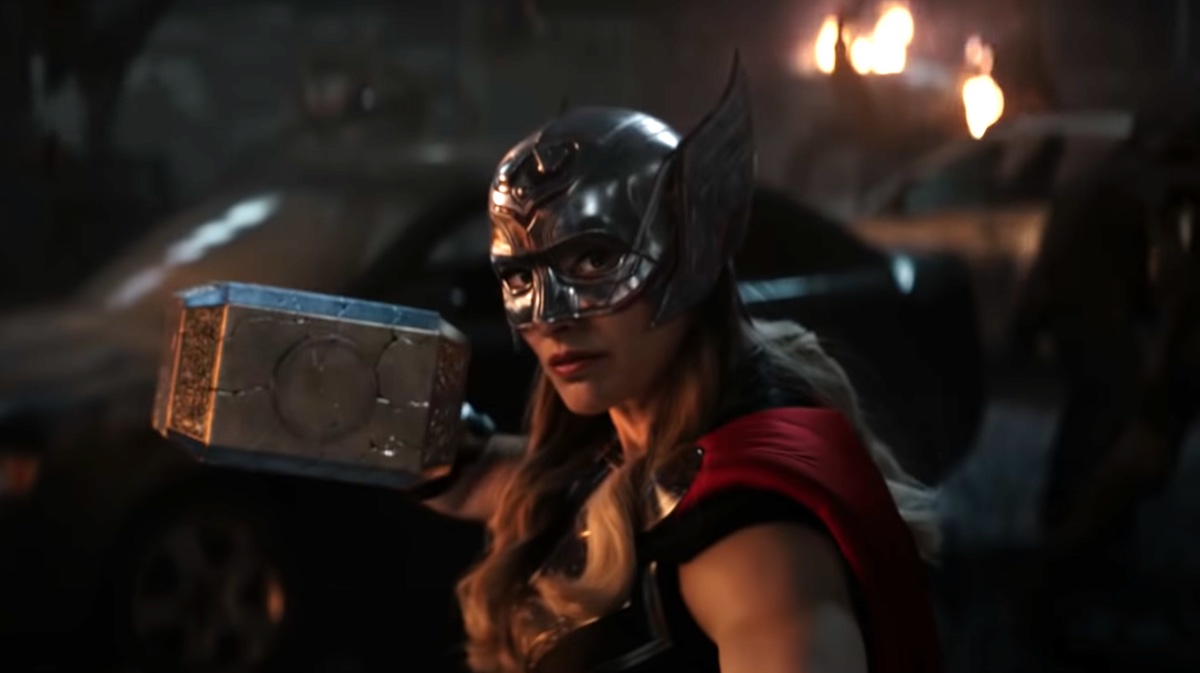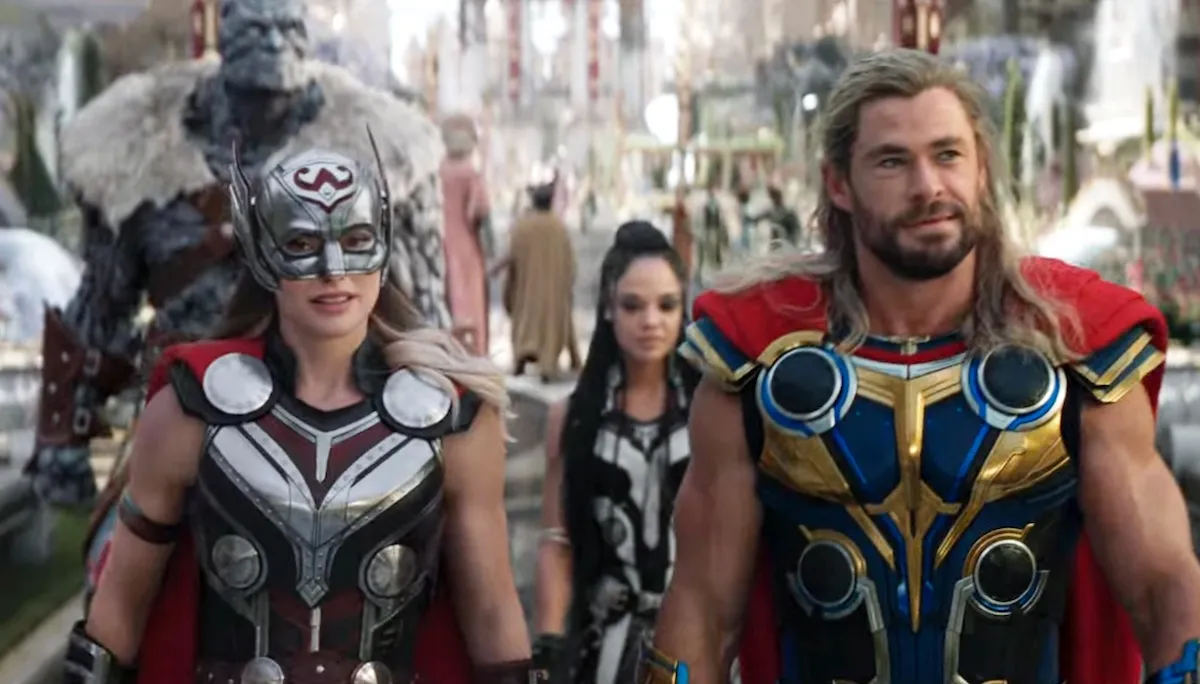It’s hard to know where to start in reviewing Thor: Love and Thunder. The movie feels like several movies in one—there’s the standard Marvel superhero fare, there’s a rousing adventure for kids about being your own savior, there’s a touching and emotionally mature love story, and there’s the film about a villain so steeped in self-righteous nihilism he’s out to prove that God is dead by killing all the Gods. There’s so much happening here that it’s hard to not get some whiplash, and the plot threads binding it all together don’t hold up to much scrutiny. This is, however, a Taika Waititi movie more than anything else, which means it’s more than worth the trip, and we can rest assured that Thor: Love and Thunder, the singular product from all these moving parts, is deeply funny and lovely to look at.
Waititi, who directed and co-wrote Love and Thunder, is responsible—along with star Chris Hemsworth—for giving Thor an entirely new lease on life. The MCU never seemed to really know what to do with the strapping space viking, even though his successful origin story, Thor (2011), helped kick off the Marvel universe as we know it today. In contrast to Thor’s troublemaking brother Loki (Tom Hiddleston), who was such a breakout hit from that film that he became the main antagonist in The Avengers and a firm fan favorite, characterization for Thor remained stilted. It felt like Marvel’s writers and directors couldn’t decide if they wanted him speaking like “Shakespeare in the Park,” to paraphrase Tony Stark, or a sort of dim bulb fish perpetually out of water. Then the narrative misfire of Thor: The Dark World bogged down the Thorverse characters, not to mention whatever Thor’s up to in Age of Ultron. It was a simple thing to write off his character as one of the least interesting in the superhero pantheon, and even Hemsworth expressed reluctance to wield the hammer in more Thor movies.
Then along came the Waititi-directed Ragnarok in 2017. It’s easy to forget these days, with Waititi absolutely everywhere, that he was a bold and surprising pick for Marvel Studios at the time. The offbeat, irreverent auteur brought his unique voice and visuals to Thor, and the result was an explosive success both critically and at the box office. Painted in candy colors and backed by show-stopping action set to Led Zeppelin’s “Immigrant Song,” Ragnarok kept true to the superhero beats while also taking us on an all-original sci-fi romp. Hemsworth’s comedic chops were finally given the room and script to shine, introducing a fresh new spin on Thor, who comes into his own by movie’s end. Considering its central core of zaniness and winking fun, Ragnarok was also a masterful balancing act in tone, with serious themes like Thor and Loki’s father Odin dying, the brothers’ on-again-off-again relationship, and the relentless brutality of villain Hela, played by Cate Blanchett, who acts as an embodiment of colonialism. It’s one of my favorite films, and I have watched it an ungodly amount of times.
Thus I have been looking forward to Thor: Love and Thunder for many years, during which the whole world underwent a sea change. With that kind of anticipation, it’s unlikely that any movie could satisfy the laundry list of things I wanted to see or my hopes for Thor and his pals. Love and Thunder comes close, but after Ragnarok, it’s almost impossible to capture the same kind of lightning in a bottle. Like most follow-ups to a big success, it’s, well, bigger, brighter, brasher, and considerably less coherent. Having seen it twice now, I keep thinking about how Love and Thunder is many movies rolled into one, and that the fun summer tentpole flick and the spirited movie for kids don’t always play so nicely with the heavier themes Waititi introduces. The fact remains, however, that I have now cried twice while watching this cinematic event. Even after telling myself I wouldn’t cry upon the second viewing, there I was crying again. Ultimately, Love and Thunder strikes enough of the right notes to make you care and make you glad to be along for the zig-zagging adventure.
Love and Thunder finds Thor still traveling with the Guardians of the Galaxy, searching for his place and purpose in the cosmos. Having lost his family, his home world, and everyone he’s loved, Thor considers himself cursed and is resigned to being alone. But a new threat in the form of Christian Bale’s Gorr the God Butcher (who does what he says on the tin) brings Thor back to New Asgard on Earth to reunite with his bestie Valkyrie (Tessa Thompson, who remains so good she needs her own movie, like, yesterday). Valkyrie, who took over Thor’s duties as King, has been chafing at the boring diplomacy and commercialism that comes with being a head of state and is glad to join in the fight. Also joining the team is Waititi’s Korg, a kindly hunk of rock who provides comedic relief and knowing commentary, and the screaming goats Toothgnasher and Toothgrinder (more on them later). It’s very, very hard not to miss Tom Hiddleston’s Loki, who provided such a perfect foil for Thor in the previous movies, but at least Thor’s new friends aren’t as liable to stab him in the back.
Thor’s unexpected reunion arrives in the form of Dr. Jane Foster (Natalie Portman), his ex and the one who got away. Jane, a genius astrophysicist who has achieved a sort of Stephen Hawking-level fame since we last saw her, also has a secret the audience knows but Thor doesn’t: she has stage four cancer. (If that feels like an abrupt turn, the storyline is in part taken directly from Jane’s development in the comics.) Unable to slow the cancer’s progression via science, she finds herself drawn to space viking magic, and ends up wielding Thor’s old weapon, the hammer Mjolnir. With Mjolnir in hand, Jane transforms into the Mighty Thor (not Lady Thor, thank you very much), but becoming a superhero also exacts a toll.

Portman may be the biggest revelation here. She was absent from Ragnarok, and had seemed content to leave the Thorverse behind her. But Waititi appears to have lured her back with a meaty role that finally does justice to Jane and finally gives her and Thor with the kind of storyline that makes you appreciate them together. In Thor movies past, Portman had frankly looked like she wanted to be anywhere but there. In Love and Thunder, she throws herself into the part headfirst. It’s an astonishing transformation—not just those buff arms that have been the talk of the Internet, but also a chance to showcase her talents as a comedic and dramatic actress and a newly minted action hero. Under Waititi’s direction, including a moving sequence that shows us how their relationship fell apart, Portman and Hemsworth have a sparkling chemistry that was not present until now. As a Jane/Thor naysayer for well on a decade, I’m thrilled to stand corrected here. It’s impossible not to root for them. In a galaxy of half-baked superhero couples, their interactions help set a new standard.
Bale also turns in a memorable performance as the villainous Gorr. Gorr, who resembles the lovechild of Voldemort and Gollum, has my favorite hallmarks of a bad guy—one whose reasons and motivations for doing what he’s doing make sense. We’re meant to sympathize with Gorr somewhat, and he spouts a constant philosophy about how the Gods have abandoned us that seems rather bleak for popcorn fare but feels all too true in our trying times. One could argue that, really, Gorr does nothing wrong, save that some of the Gods he’s butchering are innocent and nice, according to Thor, a fellow God. However, all of the other Gods that we encounter, especially Russell Crowe’s bloviating Zeus in his glittering golden city, seem like they could use some cutting down to size.
Because it’s hard to see what the problem really is with Gorr’s mission considering how much the Gods appear to suck, Love and Thunder turns to the oldest trope in the action movie book. Gorr kidnaps a bunch of the New Asgardian children, and, well, you can’t argue with saving the children. We must save the children at all costs. Think of the children! It’s hard not to feel a little disappointed in this aspect of the film, which takes the place of a compelling plot line after it’s introduced, but at least the kids are great. The young actor Kieron L. Dyer steals the whole movie every time he’s onscreen, and Waititi has assembled a vibrant cast of kids, including his own daughters, for scenes both fun and scary. There’s a battle that should delight children everywhere, the kind of moment that feels like a culmination of Waititi’s stated intention to make the movie of a ten-year-old’s dreams.
There’s no real issue with Love and Thunder being geared in a big way toward kids, and it bears some empowering messages for them. But there’s so much else going on for the adults watching, including some frightening moments with Gorr and some far more terrifying moments about the realities of cancer, that it leaves me wondering what actual kids in the audience will think. As a kid who enjoyed some pretty grown-up movies in my time, I like to give current kids the benefit of the doubt. Yet it’s difficult not to feel some dissonance between the tone-shifts that happen here—one moment, a child standing up to a bullying villain, and the next, a rumination about how the Gods have lied and cruelly used us, and there’s nothing for us after death but more death. Don’t get me wrong, I think it’s important for kids to hear the latter message, but Love and Thunder starts to become more a patchwork of smart ideas and very Waititi moments rather than, say, a tightly woven tapestry of a story.
In the end, that’s fine. Let’s be real, you’re here for the vibes. And Love and Thunder has vibes to spare. It kicks a lot of ass, has one of the most visually striking fights in Marvel memory, and rocks out to a electric soundtrack of Guns N’ Roses. It’s also laugh-out-loud funny innumerable times, including two fantastic running gags. Thor’s magical goats Toothgnasher and Toothgrinder are always screaming, and they’re never not hilarious. Then there’s the love triangle between Thor, Mjolnir, and Thor’s new weapon, the axe Stormbreaker, who is jealous of Thor’s affection for his old hammer. It’s the kind of excellently bonkers comedic bit that could only come about in a Waititi Marvel movie, and we should be very glad such things exist. Also due to Waititi’s sensibilities, we get some queerness represented here that was once infamously axed from Ragnarok, and that feels good, even if it doesn’t feel like nearly enough in a film with “love” in the title. At least we’re making some small progress in Marvel movies while the rest of society is backsliding.
Throughout Love and Thunder, Thor is on a mission to figure out who he is and who he wants to be. It would appear that the script wants to take us on the same journey of discovery, as we move through sequences exploring the nature of romance, friendship, parenthood, worship, capitalism, death, and, yeah, that “love” kicker. Whether the ending Thor arrives at works for you is probably a matter of who you are as a person, and that’s cool. Or maybe I’m overthinking this whole thing and it’s time to sit back and enjoy a summer superhero movie about space vikings and screaming goats. Either way, you’re gonna cry! Have fun, kids.
(images: Marvel Studios)
—The Mary Sue has a strict comment policy that forbids, but is not limited to, personal insults toward anyone, hate speech, and trolling.—









